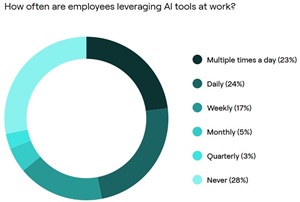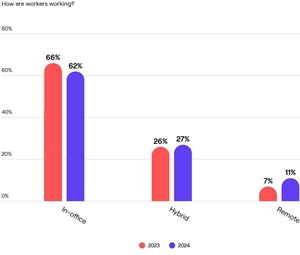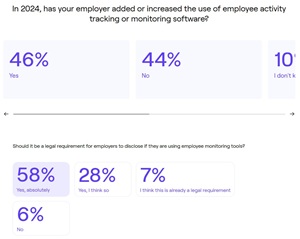News
Hybrid Work Report: 'Coffee Badging' Continues to Thwart Return-to-Office Directives
One interesting highlight of a new hybrid work report is the continuing practice of "coffee badging," where employees clock in early just to swipe their ID badges before leaving the premises to work remotely in order to thwart return-to-office directives.
Owl Labs said the practice continues in its new State of Hybrid Work 2024 report, after its 2023 report "made it go viral." In fact, the first key finding of the report as presented by the video conferencing specialist notes that 44% of workers still participate in this trend, with 70% admitting they've been caught by their employers.
"A lot has changed in just one year," the report said. "The push and pull of return-to-office mandates remain present, job listings are now very clear on in-office requirements, and employees are willing to quit jobs either outright, or quietly, if their employers aren't meeting their expectations.
"Trends like coffee badging and polyworking still remain popular, but we're seeing new trends present themselves with regularity -- in 2024, we've seen: the blend of work and social, coined #WorkTok, WFB (Work-From-Bed; formerly known as the 'sick day'), calendar blocking (protecting your calendar with pretend meetings) and the 'workcation.'"
Polyworking is the practice of holding multiple jobs or income streams simultaneously, rather than relying on a single employer. A workcation is a blend of work and vacation, where employees work remotely from locations outside their usual home or office settings.
"Despite anecdotal narratives that 'everyone's back at the office now,' we learned that 27% of workers are currently working in a hybrid format -- up one percentage point from 2023 -- and 11% are fully remote -- an increase from 7% in 2023," the report said. "Three remains the most popular number of days in-office for hybrid workers, with 41% of hybrid workers saying that's how often they go, though only 33% said this matches their preferences."
Here are some other key findings as presented by the company:
-
Over 1 in 4 workers are polyworking (28%), with another 14% planning to start in the next year. What are the main reasons for workers having an additional job?
 [Click on image for larger view.] Polyworking (source: Owl Labs).
[Click on image for larger view.] Polyworking (source: Owl Labs).
-
24% of workers say they use AI tools daily, with an additional 23% of workers using them multiple times a day.
 [Click on image for larger view.] Leveraging AI (source: Owl Labs).
[Click on image for larger view.] Leveraging AI (source: Owl Labs).
-
62% of respondents work full-time in-office, compared to 66% in 2023 -- a slight downshift.
 [Click on image for larger view.] Where Working (source: Owl Labs).
[Click on image for larger view.] Where Working (source: Owl Labs).
-
46% of workers said their company added or increased use of employee productivity or activity monitoring software in the past year, while 58& said it should be a legal requirement to disclose that practice.
 [Click on image for larger view.] Monitoring Employees (source: Owl Labs).
[Click on image for larger view.] Monitoring Employees (source: Owl Labs).
Other highlights pulled from an infographic include:
- 27% of employees are actively seeking new jobs, an increase from 23% last year.
- 75% of workers believe their employers require them to work from the office due to traditional expectations, up from 69% in 2023.
- Hybrid workers spend an average of $42 more per day when they work from the office compared to working remotely.
- 45% of workers say their employers' or colleagues' political opinions make them reluctant to go into the office.
- 22% of workers expect a pay increase if they can no longer work hybrid or remote, while 40% would seek a new job offering more flexibility.
- 43% of workers report increased stress levels compared to last year, highlighting rising work-related anxiety.
- Over one-third (34%) of workers have posted negatively about their job or employer on social media.
- 22% of workers are setting stricter boundaries by refusing to take on tasks outside of their job descriptions.
- 58% of workers “calendar block” to protect their time, emphasizing the need for structured collaboration in a hybrid work environment.
The Owl Labs blog post linked above delved further into the impact of AI on hybrid work.
"AI is making office life easier for many, with employees using it most for administrative tasks like scheduling and calendar management (35%), crunching data (33%), and whipping up content like emails and reports (30%)," the post said. "The reliance on AI increases in younger generations, with 70% of Gen Z employees and 59% of millennials saying they are reliant on it at work. A further 36% said that while they were not reliant they still use it occasionally for select tasks.
"AI is becoming so integral to the day to day of the workplace that people have fears about their jobs. More than half (52%) of employees are concerned about their job or career due to AI integration. The biggest fears include: reduced job stability and/or potential layoffs (17%), the need to learn new skills or retrain to stay competitive (15%) and fewer opportunities for career growth (13%). Gen X (51%) and Boomers (61%) are the least concerned about this, which may stem from the fact that they will retire sooner than younger generations."
About the Author
David Ramel is an editor and writer at Converge 360.